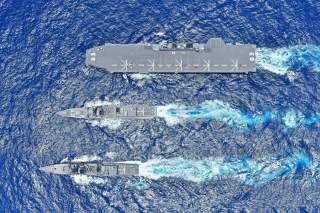Iran, Take Note? Japan May Send an Aircraft Carrier to the Middle East
Why?
Japan may dispatch an aircraft carrier to the troubled waters of the Middle East.
Except that technically, it wouldn’t be an aircraft carrier. It would be a “helicopter destroyer,” a vessel that sure looks like an aircraft carrier, and in fact is slated to become a carrier armed with F-35B stealth fighters in 2020.
Nonetheless, the Japanese government is debating whether to dispatch one of the nation’s two Izumo-class ships as part of Japan’s ongoing naval commitment to anti-piracy patrols in the region, according to the Japan Times.
“For the information-collection mission, which is independent of the U.S.-led one to protect shipping in the area, Japan will divert one of its two P-3C planes patrolling the Gulf of Aden for pirates off Somalia,” sources told the newspaper. “It is also considering deploying a helicopter carrier, since its Aegis destroyers for intercepting ballistic missiles are guarding against North Korean threats around Japan.”
“The Gulf of Oman, the northern part of the Arabian Sea and the eastern part of the Bab el-Mandeb strait between Djibouti and Yemen that links the Red Sea and the Gulf of Aden, are considered potential destinations for the mission.”
Japanese Prime Minister Shinzo Abe has ordered the Japan Self-Defense Forces (JSDF) to plan for deploying more ships and planes to the Middle East. Using a bit of legal legerdemain, “the government began looking for a mission that could be classified as ‘survey and research’ activities, which do not require Cabinet approval. What exactly ‘survey and research’ activities consist of remains unclear, but the two ruling parties will seek Cabinet approval to clarify the details of the mission, such as its objectives and exit strategy.”
In a purely military sense, an Izumo-class carrier would be a welcome – but hardly decisive – addition to U.S. and European forces in the Middle East. The two 27,000-ton Izumos – the Izumo and the Kaga – currently fly nine anti-submarine and minesweeping helicopters. In August 2019, Japan announced it would purchase 42 F-35B fighters, the short-takeoff and vertical landing variant of the U.S. F-35 family, to turn the ships into small aircraft carriers mounting perhaps a dozen or so F-35Bs.
However, sending a carrier overseas may be political dynamite in a nation still haunted by destruction and defeat in World War II. “Sending the SDF [Self-Defense Forces] overseas is a sensitive issue because entanglement in foreign conflicts could violate war-renouncing Article 9 of the Constitution,” said the Japan Times. Japanese critics also warn that Japan’s post-World War II constitution forbids “offensive weapons” such as aircraft carriers. Currently, Japan’s carrier ambitions are focused on a potential conflict with China in waters near Japan. Deploying carriers overseas, into a potential combat zone near powder kegs like Somalia, Yemen and Iran, could add fuel to the fire.
Talks within Japan’s governing coalition “could face additional headwinds over any plan to deploy one of Japan’s two Izumo-class helicopter carriers to the Middle East,” the Japan Times noted. “Sending the controversial naval vessels, Japan’s largest, to the region could be seen by critics as unnecessary — and constitutionally questionable — muscle-flexing.”
Perhaps more important, Japan imports about 90 percent of its oil from the Middle East. “Japan is under pressure to join a U.S.-led coalition to protect shipping in the Strait of Hormuz, the strategic sea lane through which around a fifth of the world’s oil passes, but is reluctant to do as it might damage Tokyo’s friendly ties with Tehran,” said the Japan Times.
Michael Peck is a contributing writer for the National Interest. He can be found on Twitter and Facebook.
Image: Creative Commons.

